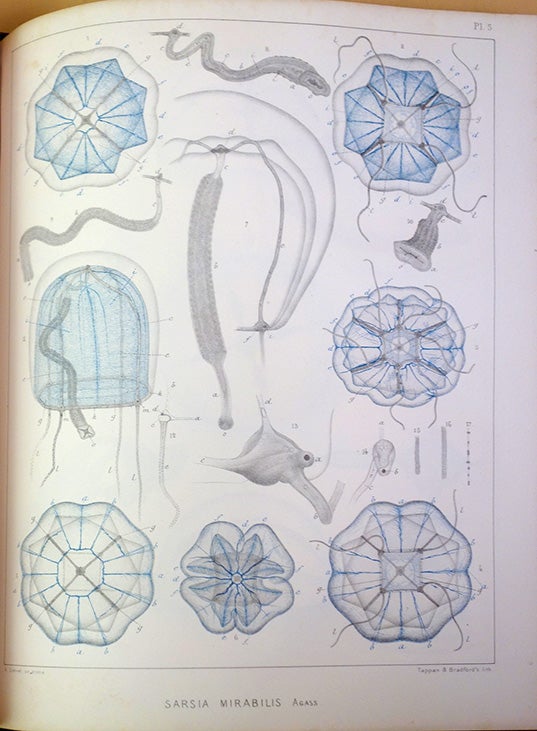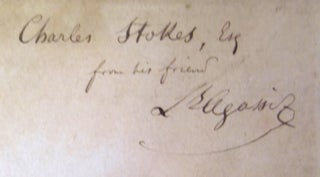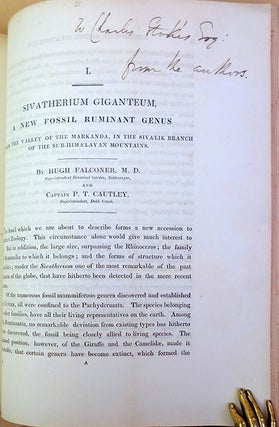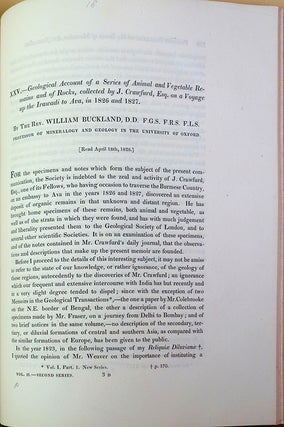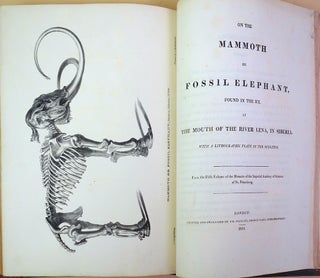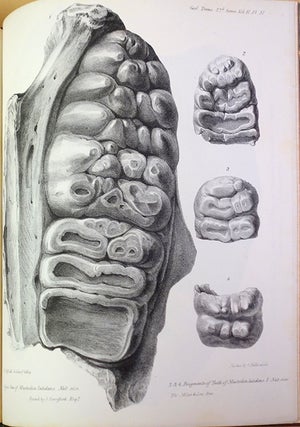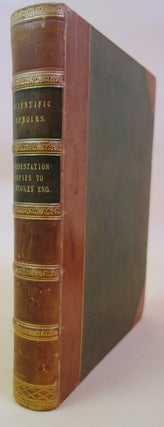Scientific memoirs. Bound collection of offprints etc. presented to C. Stokes
Publisher Information: 1817-33.
[Stokes, Charles (1785-1853).] (1) Agassiz, Louis (1807-73). Contributions to the natural history of the Acalephae of North America. Part 1.—On the naked-eyed Medusae of the shores of Massachusetts, in their perfect state of development. Offprint from Memoirs of the American Academy of Arts and Sciences, new series, 4 (1850). 221-316pp. 8 plates. Original front wrapper preserved. Presentation Copy, with the front wrapper inscribed: “Charles Stokes Esq from his friend L. Agassiz.” (2) Clift, William (1775-1849). On the fossil remains of two new species of Mastodon, and of other vertebrate animals, found on the left bank of the Irawadi. Offprint from Transactions of the Geological Society of London, 2nd series, 2 (1828). 369-375, [6]pp. 9 plates. Original front wrapper preserved, inscribed on the verso: “To Charles Stokes Esq. F. R. S. with Mr. Clift’s respectful regard.” (3) Falconer, Hugh (1808-65); Proby T. Cautley (1802-71). Sivatherium giganteum, a new fossil ruminant genus from the valley of the Markanda, in the Sivalik branch of the sub-Himalayan mountains. Offprint from Asiatick Researches, or Transactions of the Society Instituted in Bengal, for Inquiring into the History of Antiquities, the Arts, Sciences and Literature of Asia 19 (1836). 24pp. Plate. Presentation Copy, with the first leaf inscribed: “To Charles Stokes Esq. from the authors.” Bound with 21 other offprints / pamphlets (liat available on request) in one quarto volume. 279 x 220 mm. Half calf, gilt spine, cloth boards ca. 1850, minor edgewear, a few scratches on spine. Minor foxing and offsetting, but very good. From the library of Charles Stokes, amateur geologist and vice president of the Geological Society; 12 of the 24 items in this volume bear presentation inscriptions to Stokes.
(1) First Edition, Offprint Issue. Agassiz’s important paper on the hydromedusae of Massachusetts contains the first description and illustrations of nerves in jellyfish, making Agassiz “the first person to discover a nervous system in any member of the Cnidaria” (Mackie, p. 27). “Included in [Agassiz’s] 1850 paper are descriptions of nerves in several medusae, including Sarsia mirabilis Agassiz and Hippocrene superciliaris Agassiz. Previously no one had claimed that coelenterates had nerves of any sort, and Agassiz’s report was evidently treated with considerable skepticism. Contemporary workers found it hard to conceive of a nervous system that had no center, but consisted simply of strands or cords of nervous tissue as Agassiz described it” (ibid.). Faced with criticism, Agassiz retracted his description, but recent research has confirmed that he was in fact correct in his identification of nervous tissue in hydromedusae. Mackie, “The first description of nerves in a cnidarian: Louis Agassiz’s account of 1850,” Hydrobiologia 530/531 (2004): 27-32.
(2) First Edition, Offprint Issue. Clift’s memoir contains the first description of Stegolophodon latidens, a new species of mastodon discovered in the fossil collection shipped from Burma to England by colonial administrator John Crawfurd (1783-1868). Crawfurd’s important fossil collection was further discussed by William Buckland in his “Geological account of a series of animal and vegetable remains and of rocks, collected by J. Crawfurd, Esq.,” also included in this volume.
Clift’s paper provided important confirmation for Cuvier’s concept of extinction, introduced in his famous “Mémoire sur les espèces d’éléphans vivantes et fossiles” (1799). In that paper Cuvier demonstrated anatomically that fossil mammoths and living elephants were distinct species and made a convincing case for the reality of species extinction, challenging the widely held view that the natural world was complete and perfect as created by God. Skeptics countered that mammoths, while extinct in Europe, could still possibly be living in other parts of the world; however, Crawfurd’s discovery of mammoth fossils in Burma lent credence to Cuvier’s argument.
(3) First Edition, Offprint Issue. Falconer, a surgeon with the British East India Company, discovered the Siwalik fossil beds in the outer Himalayas and established his reputation as a paleontologist with his descriptions of the fossil animals found there. He often collaborated in these researches with British engineer Proby T. Cautley, designer of the Ganges Canal and an active participant in the Siwalik Hills fossil excavations. Falconer and Proby’s paper, published in an Indian scientific journal, contains the first account of Sivatherium giganteum, an extinct giraffid species that ranged throughout Africa to the Indian subcontinent. Sivatherium giganteum is the largest giraffid known and may represent the largest ruminant of all time: Recent estimates assign it a height of three meters at the shoulder and a body weight of about 1250 kg (2760 lbs.).
These three significant papers, all with presentation inscriptions from their authors, are bound in a collection of 24 papers on geology, paleontology and natural history by several well-known British and American scientists. Among the authors represented are William Buckland (four papers), author of Reliquiae diluvianae (1823) and the first to publish a full account of a dinosaur; William Clift (two papers), comparative anatomist and the first curator of the Royal College of Surgeons’ Hunterian Museum; and American naturalist Isaac Hays, whose “Description of a fragment of the head of a new fossil animal” (no. 15 below) established the new fossil genus Saurodon. The volume is from the library of Charles Stokes, a wealthy stockbroker who numbered Charles Darwin and the painter J. M. W. Turner among his clients; he was also an amateur geologist who served a vice president of the Geological Society of London and amassed a large collection of geological and natural history specimens. Twelve of the 24 papers contained in the volume are inscribed to Stokes.
Book Id: 44479
Price: $4,000.00

